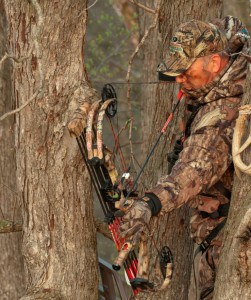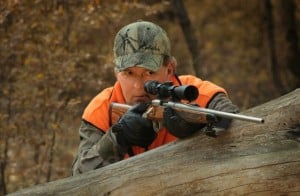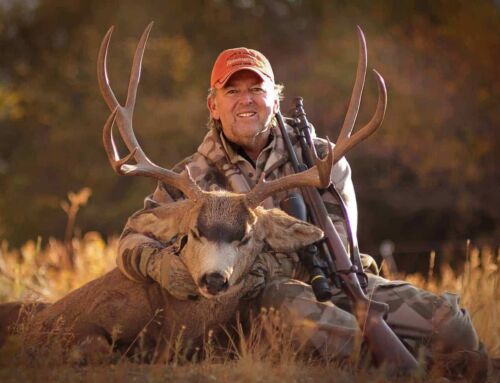I’ll be bowhunting big bucks in the South in December? Weather-wise, which days should be best?
Try to plan your hunts around cool, clear days with a north wind. “Down here, big bucks move the best on cool, bluebird days,” says Jimmy Riley, manager of Giles Island Plantation near Natchez, Mississippi. “We have lots of days when it’s warm and the wind blows out of the south. Deer don’t move as well then. But if you can catch a couple of crisp, clear days, you should spot some awesome buck movement.”
What are pheromones?
Pheromones are chemical substances in the urine and glandular secretions of deer. They serve as stimuli to other deer for behavioral responses. Many biologists believe that pheromones emitted by does trigger the peak of the rut and throw bucks into major breeding mode.
I plan to do a little late-season squirrel hunting this winter. Which days should be best?
Squirrels tend to move best on cool, clear mornings. But if it’s bitter cold, they’ll stay in their dens or nests an hour or so after sunrise, waiting for the woods to warm up a little bit before moving. Grays don’t move very well on rainy or misty mornings either.
What is “gap shooting”?
Some traditional archers use the gap-shooting method. Here’s how it works. You draw an arrow (with fingers), focus on the target and then peek at the point the broadhead. Then you aim and judge range according to the gap between the broadhead and the target. This type of shooting obviously requires a lot of practice to perfect.
I’d like to buy a new shotgun for my 10-year-old son. Any suggestions?
You can’t go wrong with the 20-gauge Remington 870 Express Youth Model. Its short stock and length of pull fit most kids well. The pump action is safe when you load one shell at a time. Start your kid with a manual shell shucker; if he wants to, he can move up to an autoloader when he gets older. The Remington youth gun comes with a 21” barrel and a good, all-around modified choke tube for shooting 7/8-ounce loads at clay birds, doves, squirrels and rabbits.
I’ve got one buck tag and 2 days left to hunt. What is my best tactic?
First, find what deer are eating right now. A patch of standing corn or a pocket of late-falling acorns is nirvana. And re-check a harvested grain field or food plot where you hunted back in October. Even though a field receives moderate to heavy pressure throughout the season, a big buck will still hit it when food is scarce in winter.
I’m tired of sitting in a tree stand and not seeing many deer. How can I make something happen?
Try a little still-hunting? Pick a rainy day when the woods are quiet. The morning after a light snow is best. You can pad along like a ghost and maybe cut a smoking track. An old, gray buck up ahead will pop out like a neon sign against the white backdrop. Stay high on a ridge or hillside, creep slowly and pause every few steps behind trees. Glass down into draws and bottoms. Only the hardiest brush and vegetation is still standing. Dissect every inch of it with your binocular. Look for a piece of a feeding or bedded deer—a twitching tail, a flickering ear or, best of all, a glinting tine.
Should I sight-in my rifle with 3- or 5-shot groups?
I recommend 3-shot groups when sighting-in a hunting rifle. If you shoot five-shot groups the barrel heats up too much and the bullets’ point of impact (POI) keeps changing. Whether you’re using a .270 or a .338 sight-in 2 to 2 ½ inches high at 100 yards, which puts you dead-on or thereabouts at 200 to 220 yards.
How often should I clean my .270?
Clean a rifle after shooting 10-20 rounds. Some guns hold POI with a clean barrel, but many require a “fouling” shot, which blows out any cleaning residue and makes shots 2 and 3 accurate. Find that out at the range with each new rifle you purchase.
When hunting out West, I have trouble spotting elk or mule deer. Got any glassing tips that will help me out?
Break big country into quadrants. Glass one section slowly and methodically, and move to the next section and the next… Then go back and glass each quadrant again. A buck or bull might step over a ridge or out of a draw and into view at any time. Glass for a flickering ear or tail, the glint of an antler, a flat, furry backbone in vertical timber… Find a piece and a whole animal will suddenly materialize in your optic.
Is old ammunition safe to shoot and hunt with?
If ammunition is not exposed to excessive heat or moisture, and if it is stored properly in a dry place, it has a very long shelf life—10 years, 20 or maybe even longer. But if you see rusted or corroded cases and or/bullets, don’t shoot it.
Which rifle calibers do you recommend for elk?
Three calibers top my list: .30-06, 7mm Mag., and 7mm Rem. Mag. Shoot a minimum 150-grain bullet.
I’ll be bowhunting moose in grizzly country this fall. Got any tips for avoiding a bear encounter?
Your chances of encountering a grizzly are slim, but still you’re smart to plan ahead for the unknown. Carry a can of bear spray and keep it handy as you hunt and in your tent at night. In camp, store food and trash well away from your sleeping area; it’s best to hang the stuff high in trees. If you spot a bear at a distance, glass it and enjoy the experience, but don’t stalk too close. If you bump into a bear on a game trail, freeze and get out your spray. Back slowly out of the area. Remember, a grizzly wants to avoid a close encounter with you, too.
I just scouted a new piece of deer ground that has 3 major creek drainages running through it. Which of those creeks should I hunt?
Set your stands set where two or more ridges petered out into a wending creek bottom. Ridge bases and creeks (or rivers, sloughs, oxbow lakes and the like) are typically rimmed with cover and pocked with deer tracks, rubs and scrapes. They form 3- or 4-sided funnels that squeeze whitetails within bow or gun range.
Should I hunt whitetails on the edge of a big pine thicket, or hike back into the cover and hang my stand?
Bucks are notorious for traveling edges, where they love to rub and scrape along the way. When bowhunting, hang a stand in the dark, dense edge of pines, cedars, etc. That’s where big deer like to walk, and you’ll be well hidden in there. When hunting with a scoped rifle, slug gun or muzzleloader, set up 50 to 100 yards away and watch for a buck running a sign-blazed edge. Of course if you don’t see any deer or if pressure heats up in the area, you might have to hunt deeper in the thick stuff. But try the edge first.
I read the other day about an “off side” tree stand setup. What is that?
If you shoot right-handed, pick a tree to the right side of a well-used trail (you southpaws choose a tree to the left of a game run). Then strap a stand to the tree opposite of where you expect a buck or bull to come. When you hear an animal approaching from behind, sit tight. If a good buck or bull walks by and quarters away on your shooting side, kill him with little chance of getting busted.
I’ll be bowhunting a tract of big woods this September, where should I set up?
Zero in on white and red oak acorns, but don’t overlook isolated pockets of persimmons, crabapples, wild grapes, honey locust, pokeberries and the like. Deer love to fatten up on soft mast when they can in September. Coming to “hot” trees from all directions, does and fawns leave secondary trails that resemble spokes on a bicycle wheel. In mid-September and early October, bucks hang out near mast ridges, flats and bottoms. As they gobble acorns and soft fruits and make early contact with does, bucks blaze signpost rubs and rub-mark travel corridors between bedding and feeding areas. Evaluate the terrain, foliage and prevailing breeze. Then hang a tree stand in one of two places: downwind of a “wheel spoke” doe trail near heavy mast, or along a shiny rub line in the vicinity of signpost rubs. You ought to see a good buck one afternoon.
I’ll be hunting pronghorns in Wyoming later this year. How about some tips on rifles, loads and shooting at goats?
A good antelope rifle shoots a 100- to 150-grain bullet fast and flat. The .243, .25-06 and .270 are good choices; the .30-06 is the upper end. Top your gun with a quality, variable scope (3X-9X or even 4X-14X is the ticket). Sight-in 1 ½ to 2 inches high at 100 yards, and know what a bullet is doing out at 300 and even 400 yards. The first shot at a standing antelope is important. Take your time and make it count. A bipod on your rifle helps. If you miss with the first shot you’re apt to get running shots after that, and things really get interesting.
After climbing into a tree stand, what is the first thing I should do?
First thing when you climb into a bow stand, secure your harness and make sure you feel safe and comfortable. Then nock an arrow and swing your bow around to troubleshoot potential shooting snags before a buck strolls into view. Make sure you can turn and shoot easily left, right and out front; if a limb snags your bow, clip it.
Give me a few tips on clipping bow-shooting lanes.
Trim at least 4 lanes so you can shoot at a buck that approaches from any direction. Reach above your head and saw limbs; the fresh cuts will be above a buck’s sight plane. Saw saplings at ground zero, and cover the white cuts with leaves and dirt. Drag trims downwind of your stand and stick them in the ground where incoming deer cannot see them or smell your lingering scent on them. When hunting public land, check regulations to make sure trimming trees is legal.
Should I unload my muzzleloader after every hunt, or is it okay just to remove a cap and leave the gun stoked with powder and a sabot?
With today’s quality rifles, people get lulled into thinking they can load a gun and hunt with it for days or even a week, simply uncapping the rifle each night for safety. Sometimes I’ll go 2 days, but rarely more than that. You really ought to empty a gun after every hunt, and ram a fresh load down the bore the next day. Technology aside, a muzzleloader is a muzzleloader—finicky. Swabbing a rifle’s bore and reloading each day is a bit of a hassle. But it’ll make your gun go boom! when it finally comes time to shoot at a buck or bull.







